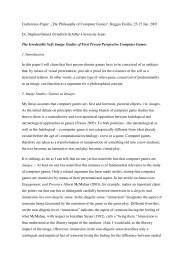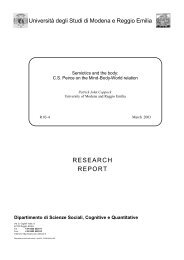Playing Dress-Up: Costumes, roleplay and imagination
Playing Dress-Up: Costumes, roleplay and imagination
Playing Dress-Up: Costumes, roleplay and imagination
You also want an ePaper? Increase the reach of your titles
YUMPU automatically turns print PDFs into web optimized ePapers that Google loves.
<strong>Playing</strong> <strong>Dress</strong>-<strong>Up</strong> Ludica<br />
part, such as shoulders, chest, legs, etc. In addition to its aesthetic appearance, each piece of<br />
armor also has an Armor Class, or AC, statistics that are weighed along with a number of other<br />
numerical signifiers. (Figure 3) These statistics are calculated in relation to the stats of your<br />
enemies, combined with a digital die roll, to determine the outcome of battles, your characters<br />
skills <strong>and</strong> experience. When you are being attacked, the level to which you take damage is<br />
partially determined by your armor class. In the context of this type of mechanic, many players<br />
engage in a strategy that could be characterized as “dress-up by the numbers.” They keep detailed<br />
track of the values of various armor items, seek out high-AC items, <strong>and</strong> treat the costume as a<br />
statistic more than a decoration or form of personal expression. Other players typically combine<br />
the statistical <strong>and</strong> aesthetic features of armor to help construct their game identity <strong>and</strong> combat<br />
performance, which are integrally intertwined. It is also interesting to note that in this context,<br />
expression is sometimes at-odds with performance, <strong>and</strong> as a result, players might be conflicted<br />
between “gear” (as it is typically referred to) they like aesthetically vs. gear with higher stats.<br />
Figure 3: Armor stats in World of Warcraft. (Image: Pearce)<br />
A radically different example of instrumental costume play takes place in the Nintendo 64 game<br />
The Legend of Zelda: Majora’s Mask (2000). In this single-player game, the main character,<br />
Link, collects a series of masks, each of which imbues the wearer with a magical power,<br />
sometimes an entirely new physical form. They serve as animal totems, <strong>and</strong> as Link obtains them,<br />
he can use them strategically for the skills they endow.<br />
• Acquiring/Trying Clothes: The specific mechanism by which players acquire clothing in games<br />
has significant impact on play patterns. In The Sims, for instance, players can buy clothing for<br />
their Sims either in-game or via fan-made web sites; clothing acquisition takes place “out of<br />
world” so that players are not obtaining clothes in-character per se. In There.com, players<br />
Philosophy of Computer Games 2007 Page 6






